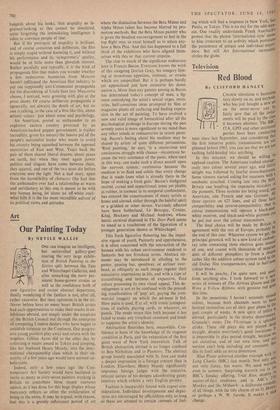Art
Our Painting Today
By NEV1LE WALLIS
ONE can imagine an intelligent, but untravelled gallery-goer touring the very large exhibi- tion of British Painting in the Sixties split between the Tate and Whitechapel Galleries, and after remarking the more per- sistent home-grown strains as well as the confidence both of new figurative and recent abstract departures, finally wondering if the fanfare is not, after all, rather excessive. But then optimism is in the air. Never before have so many lesser British artists had such opportunities to make their marks in ex- hibitions abroad, not simply under the auspicies of the British Council but through the enterprise of competing London dealers who have begun to establish outposts on the Continent. Our progres- sive young painters play away and return with the trophies. Gillian Ayres did so the other day by collecting a major award in Tokyo and jumping, like her husband Henry Mundy, into the inter- national championship class which in their ob- scurity of a few years ago would have seemed un- believable.
Indeed, only a few years ago the Con- temporary Art Society would have hesitated to invite as many as sixty-seven painters working in Britain to contribute three recent canvases apiece, as it has done for this huge display whose buoyancy reflects so often the exhilaration of being in the swim. It may be argued, with reason, that this is a grossly inflationist period of art
where the distinction between the Beta Minus and Alpha Minus talent has become blurred by pro- motion methods. But the Beta Minus painter who is given the headiest encouragement to feel in the top flight may so excel himself as to attain any- how a Beta Plus. And this has happened to a full third of the exhibitors who have aligned them- selves with this or that current impulse.
The clue to much of the significant endeavour here is Francis Bacon. Everyone knows the work of this unageing Dorian Gray, his imagery hint- ing at monstrous appetites, violence, or strains which are unspecified. But it is perhaps hardly yet appreciated just how extensive his domi- nation is. More than any painter among us Bacon has determined today's concept of man, a fig- ment embodying the artist's sexual urges, mem- ories, half-conscious ideas prompted by film or magazine photo all surfacing and finding expres- sion in the act of painting. To have evolved a new and valid image of humankind after all the psychological probings in Europe during the past seventy years is more significant to my mind than any other trends or rediscoveries in recent paint- ing. Bacon's feeling about his medium may be shared by artists of quite different persuasions. 'Real painting,' he says, 'is a mysterious and continuous struggle with chance—mysterious be- cause the very substance of the paint, when used in this way, can make such a direct assault upon the nervous system; continuous because the medium is so fluid and subtle that every change that is made loses what is already there in the hope of making a fresh gain.' Bacon's disfigured mortal, carnal and apparitional, tense yet pliable as rubber, in torment in its temporal confinement, has entered the consciousness of many artists at home and abroad, either through the baleful spirit or a gridded or other device. Variously affected have been Sutherland, Le Brocquy, Crozier, Kitaj, Hockney and Michael Andrews, whose hectic carnival disposed in The Deer Park seems to stand as a touchstone of the figuration of a younger generation shown at Whitechapel.
This fresh figurative flowering has the impul- sive vigour of youth. Painterly and apprehensive, it is often concerned with the interaction of the human with his urban environment rendered in fantastic but not frivolous terms. Abstract ele- ments may be introduced in alluding to the poster, passing bus, speedway, or airliner over- head, as obliquely as such images register their associative impressions in life, and with a type of streamlining and tartness of expansive, fluid colour possessing its own visual appeal. This de- velopment is not to be confused with the preced- ing manifestation of 'pop' art, guying the com- mercial imagery on which the ad-mass is fed. Here paint is used, if at all, with ironic juxtaposi- tions of starlets, playing cards, or whatever, on panels. The mode wears thin both because it has failed to make any trenchant comment and tends to suppress the artist's identity.
Abstraction flourishes here, meanwhile. Con- fidence is born of the knowledge of its stagnant condition in Paris, and the exhaustion of the first giant wave of New York innovation. Talk of British abstraction abroad is no longer confined to Ben Nicholson and to Pasmore. The abstract group loosely associated with St. Ives can make a deeper impression in a foreign context than in London. Elsewhere, Henry Mundy significantly impresses foreign judges with the tentative, reticent nature of his designs adumbrating gauzy interiors which exhibit a very English probity.
Fashion is inseparably bound with export con- siderations. Individual developments and depar- tures are encouraged by officialdom only so long as these are attuned to certain currents of feel-
ing which will find a response in New York, San Paulo, or Tokyo. This is no day for the odd-mall: out. One readily understands Frank Auerbach s protest that the phrase 'international style' seems to him irrelevant to an activity .which,postulate.s the persistence of unique and individual expert' ence. But still Art International inexorablY circles the globe.


































 Previous page
Previous page